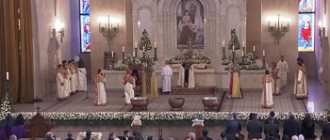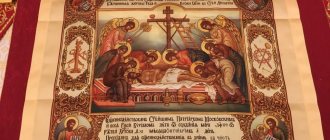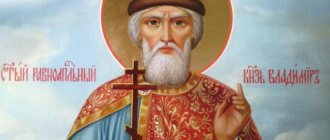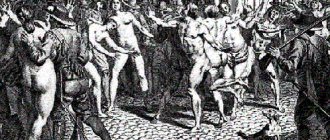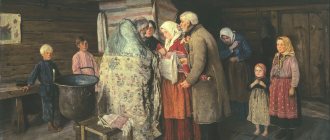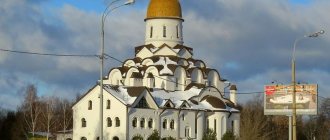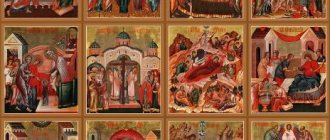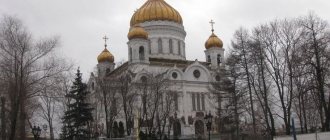In 2021, Poland celebrated a very important event - the 1050th anniversary of the country's baptism. Once upon a time, back in 966, the first ruler of the country, Prince Mieszko I, made a difficult but only correct decision - he himself and his subjects, who were adherents of pagan beliefs, converted to Christianity. “Where there is baptism, there is hope” - these words from a song written for the anniversary of the baptism of Poland speak perfectly to the fact that Mieszko I led his state in the right direction. It was he who gave hope to his country, and thanks to the adoption of Christianity, Poland became a developed Western European state, and the far-sighted prince remained in the memory of the Poles as Saint Mieszko the Baptist.
Religion in Polish lands before baptism
Before the adoption of Christianity, polytheism reigned in the lands where Western Slavic tribes lived. Pagan deities were worshiped here, so the Slavic religion was closely connected with the deification of the forces of nature - wind, rain and sun, with farming, with folk customs and the cult of the dead. But these pagan beliefs were not formalized into any coherent system, therefore they cannot be called religious teachings. It was more like a collection of various cults and beliefs. Paganism did not have national characteristics inherent to one people, therefore they were united around a common deity only on a territorial basis.
In the pagan religion there were neither places of worship where rituals were held, nor a class of religious ministers. Worship of the gods or sacrifices were carried out in special sanctuaries built on the hills.
Pagan religion could not become the force that would unite the people living on Polish lands. And they were pushed to such a unification by vital necessity - fear of the forces of nature, fear of loneliness and a feeling of abandonment, the inability to confront enemies alone, as well as the desire to explore the world outside the borders of their tribe. And only conversion to Christianity helped to unite and create a strong state that was taken into account in Europe.
Church of the Holy Spirit - Bialystok (Poland) Today we invite you on a journey through Orthodox Poland. Yes, you heard right. It is common knowledge that the majority of Poles are Catholics. However, there is a region in northeastern Poland where a third of the local residents are Orthodox. We are talking about the city of Bialystok. There are more than ten Orthodox churches here. And the largest temple in Bialystok, and indeed the entire Polish state, is the Church of the Holy Spirit.
The authorities did not give permission for the construction of a new temple for a long time. And although at that time there were already two Orthodox churches in the city - St. Nicholas the Wonderworker and the Prophet Elijah, they could not accommodate everyone. And finally, in 1981, such permission was received. And already in August of the following year, the foundation stone was solemnly consecrated. Construction of the temple lasted 7 years. The cathedral is amazing in its size. The building is 55 meters long and 38 wide. And the largest of the five domes rises as much as 50 meters. The project was developed by Polish architect Jan Kabak. It was supposed to be a temple in a modern style and in the shape of a candle flame. And indeed, the outside of the cathedral is so intricately decorated with multi-tiered semicircular slabs that it resembles a candle. The inside of the temple vaults was decorated with frescoes in the Byzantine style. A few years ago, a sixty-meter bell tower was erected nearby. The Church of the Holy Spirit was built by what is called “the whole world.” Almost every family in Bialystok took part in collecting money. A carver from Belarus, Nikolai Bakumenko, took part in the production of the iconostasis. He also created a new worship cross, which stands in front of the church building on the site of the previous oak cross made during the founding of the church. The consecration of the giant cathedral at the end of the last century was performed by His Beatitude Metropolitan Savva of Warsaw and all Poland. And, despite the fact that the church can accommodate up to two and a half thousand believers, on major church holidays there is nowhere for the apple to fall. ORTHODOXY IN POLAND: FAITH WORN FOR CENTURIES Interview with the curator of the exhibition “Orthodoxy in Poland” Anna Radzukevich The Holy Spirit Church in Bialystok is the largest Orthodox church in Poland. Its height is 54 meters, it was built in the early 80s of the last century. How much do we know about our brothers in faith living in the neighboring state - about their history, as if woven from dramatic changes, and today, so rich in bright manifestations of spiritual life? In many ways, this gap is filled by the events of last October - the visit of the Primate of the Polish Orthodox Church, Metropolitan Sava, the exhibition “Orthodoxy in Poland” and a scientific conference on the same topic, meeting the guests - representatives of the Polish Orthodox Church, with which we have much in common: the closeness of peoples, common historical paths. One of these most interesting interlocutors for us was Anna Radzyukevich, curator of the exhibition organized by the Prince Konstantin Ostrogsky Foundation (Bialystok), author of the book “Light from the East” about the history of Orthodoxy in Poland, published in Russian and English and equipped with magnificent illustrations of Polish photo masters. — Please tell us, Anna, about your foundation. — Do you know that the number of Orthodox Christians in modern Poland is quite small? And yet, despite this, we feel like heirs of the great Byzantine-Russian religious tradition and culture. We remain aware that at a time when the Polish-Lithuanian Commonwealth was a multinational state, when the Jagiellonian royal dynasty was in power - from the end of the 14th to almost the end of the 16th century, Orthodox Christians made up about 40 percent of the country's population (about the same was at that time number of Roman Catholics). Against the backdrop of turbulent historical events, the position of Orthodoxy in our land changed, but one way or another, Eastern Christianity was a constant and important component of the confessional structure of the Polish state for more than a thousand years of history. An international festival of church music has been held in the Holy Trinity Cathedral of Gainovka since the early 80s of the 20th century. It was here, under the arches of the ancient temple, that church choral performances at such a high level began to be held for the first time in the world. Our Foundation is engaged in the preservation and development of Orthodox traditions, the dissemination of Orthodox culture. It's been around for a few years now, and we initially faced financial difficulties. We have now received funding from the Polish Ministry of Culture as part of the program for disseminating Polish culture abroad. Work on the project for the exhibition “Orthodoxy in Poland” has been going on all these years; we sought, first of all, through an extensive photographic exhibition to convey mainly the current state of Orthodoxy in Poland, although it also contains historical moments. At first we thought of starting the exhibition in Greece – in Thessaloniki. But, apparently, it was necessary that the first city where she arrived should be Moscow - the largest Orthodox center in the world and the most famous temple in Russia and beyond - the Cathedral of Christ the Savior. — If we briefly characterize this “modern state,” what are its main features? — We can say that, starting from the 80s of the last century, the Orthodox Church in Poland has been on the rise - it was granted rights that allowed it to develop, and it uses them. A great event for our Church was the settlement in 1991 - for the first time in a century - of its legal status equal to that of the Roman Catholic Church. Over the past two decades, many new churches have been built, the life of monasteries has been restored, and Orthodox brotherhoods have been created. Orthodox priests carry out their missions in the army and police, in hospitals and prisons. Since the beginning of the 90s, schools and preschool institutions have introduced the study of the foundations of the Orthodox faith. The pilgrimage movement is actively developing, charitable work is being carried out, and publishing houses are operating, producing Orthodox literature and periodicals. Church in Bialowieza with a ceramic iconostasis, which was built by Emperor Alexander III. There are only two such unique iconostases in the world. Our work in the field of church singing speaks of the revival of liturgical life. For example, an international festival of church music is held annually in the Holy Trinity Cathedral of Gainovka, which brings together singing groups from Poland, Russia, Belarus, Ukraine and other countries. The highest achievement of church singing is the “Suprasl Irmologion” - the oldest known book of church singing. In 1972, it was discovered by the famous Moscow musicologist, professor at the Conservatory Anatoly Konotop. Now it is an inexhaustible source of inspiration for monastic choirs in Eastern Europe. We have many church choirs in Poland, especially youth and children's choirs. Some parishes even have several singing groups. All these stages of life - liturgical, monastic, communal - are reflected in the photographs of our exhibition. And our main goal was to show people, including young people and very children, who came to Orthodoxy, to convey their inner spiritual world, their desire to take root in the church tradition. img src=“” alt=”” /> Thanks to the iconographic school in Bielsk Podlaski, the traditions of Byzantine icon painting are being revived in Poland. — What, in your opinion, attracts young people to churches? Is there some common cause that unites the Orthodox youth of Poland during non-liturgical times? — Such religiosity, I would say, is in our tradition. Thus, the tradition of fraternities, where boys and girls can find use for their strengths and meet interesting people, has existed in Poland since the 16th century. The fact is that we have always existed between the Western and Eastern worlds. And the task was always to establish oneself in the eyes of both Polish society itself and Roman Catholics. This means tirelessly fighting for your cause, defending the interests of the Orthodox Church on Polish soil. With the beginning of the revival of Orthodox life in Poland, the Brotherhood of Orthodox Youth was created in 1982 - the first secular Orthodox society in the entire bloc of socialist countries. And it went beyond the Iron Curtain, establishing cooperation with many similar organizations in Western Europe and America, as well as with the Greek youth organization Syndesmos. In 1995-1999 the general secretariat of the latter was located in Bialystok and was headed by the representative of Poland, Vladimir Misiyuk. It was the Brotherhood of Orthodox Youth that revived the tradition of pilgrimage to the holy Mount Grabarka, and in recent years has taken an active part in organizing many pilgrimage and missionary trips, conferences and meetings with their peers from other countries. Every year this brotherhood organizes about 30 youth camps, where its participants have the opportunity to engage in various activities - from cycling trips to studying icon painting. For example, in Bielsk Podlaski there has long been an icon painting school that revives the best Orthodox traditions. Another obvious advantage of such camps is that the guys have the opportunity to communicate, which is extremely important for them. Many people work on Internet pages. For example, not long ago an extensive Orthodox photo catalog was created with an accompanying forum in several languages. One cannot but rejoice at the opening of the Institute of the History of Byzantine Art, which arose at the Jagiellonian University in Krakow. Pilgrims going to the holy mountain Grabarka. — What problems do Orthodox citizens face in today’s Poland? — Thank God, now in Poland we have established good relations between the Church and the state. We remember from history that this was not always the case - especially during the war period and after the end of World War II, when the Orthodox were resettled to new lands. But even in this difficult, godless time, faith remained. Now, let me remind you, the state even finances individual Orthodox projects, such as this project of our Foundation. An important milestone was the return in the 90s of the Suprasl Lavra (the monastery is more than 500 years old), which was captured by Catholics in the interwar period. The Orthodox sought the return of this shrine to them back in those years, but then, in conditions of constant persecution, they could not really count on a positive solution. Now the Annunciation Cathedral of the monastery - one of the pearls of ancient architecture of Central-Eastern Europe - is being restored by the Orthodox Church. In front of the Wroclaw Cathedral. For several centuries, this temple in Wroclaw belonged to the Evangelicals, later to the Catholics, and now, restored from ruins after the Second World War, to the Orthodox. In front of the Wroclaw Cathedral. For several centuries, this temple in Wroclaw belonged to the Evangelicals, later to the Catholics, and now, restored from ruins after the Second World War, to the Orthodox. -What can be said about the participation of Orthodox believers in Poland in public life? — As Metropolitan Savva of Warsaw and all Poland says, when they do something bad to us, we shout about it loudly. And if they do good to us, then we thank them. Since the beginning of the 90s, the Law of God and catechism have been taught in Polish schools at the expense of the state. Moreover, no religious conflicts arise because of this. Orthodox classes on the Law of God are the first or last lesson - then Catholic children simply do not attend these classes. Or classes take place simultaneously: Catholics go to their teacher, Orthodox - to theirs. It is very important that now in Poland the Orthodox Church is present in all spheres of public life. It is important to understand this diversity of spiritual life, to help Orthodox believers in Russia appreciate the dynamism and openness of our Church. The main church of the Supralsky monastery - the Annunciation of the Blessed Virgin Mary - was destroyed by the Germans in 1944. Its restoration has been going on since the 80s. “Today it is obvious to any sane person that a person cannot live without faith. In Poland, there is not only a revival of Orthodox traditions, but also the rooting of the younger generation in them. We see tangible results manifested in children who study the Law of God. Of course, a teacher of the Law of God must do his job with love for children. When you see a six-year-old child in a brilliant surplice being read by the Apostle in the middle of the church, you understand that truly, in the words of the Savior, “of such is the Kingdom of Heaven.” As for the attitude of society towards the teaching of religion in school, we have never had any conflicts on this basis. — What kind of relationship do Orthodox believers have with Catholics? — Above, we already mentioned the conflict that arose regarding the Supral Lavra. Roman Catholics believed that this ancient monastery should belong to them. The struggle lasted for several years, primarily at the level of parliament and government. Now everything has fallen into place, and, in general, we, thank God, have no interfaith conflicts. At the same time, we must constantly defend the values of Orthodoxy. After all, if we ourselves do not treat Orthodox culture with care, then, naturally, other people will have a corresponding attitude. If we ourselves do not defend the centuries-old Orthodox tradition in Poland, then we may be pushed to extreme positions. Holy Mountain Grabarka. — Now you have a great church revival going on - many churches are being built, the Russian Church is bringing Divine truths to the most diverse social groups. Of course, I would like to wish that contacts between Orthodox believers in our countries develop even more fruitfully. Polish Orthodox youth have good relations with guys from Serbia, Greece, Romania, and Belarus. Such contacts could be carried out, for example, in the field of pilgrimage. I believe that with God’s help, more and more people will pray in churches on Russian soil.
Author:
Tatiana
We publish in the telegram earlier than on the website. Subscribe to the Pravlife Channel
Tags
- Orthodox churches in Poland
Reasons for accepting Christianity
Paganism, which still flourished on Polish lands in the 10th century, did not contribute to the unification of Poland into an independent state; moreover, it hampered the development of feudal relations. And in order to establish such relationships and somehow justify the wealth of one part of society and the poverty of another, a new ideology was needed.
Paganism isolated Poland from Christian Europe and prevented the development of trade and international relations with developed European countries.
In order to push a people living over a vast territory to move from a pagan faith to a Christian one, certain circumstances were necessary.
And the most important circumstance due to which Mieszko I decided to baptize Poland, of course, was the political moment. Western Europe, which adopted Christianity much earlier, under the motto of “converting” new lands, wanted to increase its territories. And the lands where the tribes of pagan Slavs lived - Polans, Pomorians, Lubushans, Mazovshans, Goplians and Vistulas - were ideal for expansion. Therefore, in order to avoid the conquest of these territories and the forced conversion of the population to a new faith, Prince Mieszko I decided on the voluntary Christianization of Poland.
“In Poland, Ukrainians and Belarusians call themselves “Russian people” or “Orthodox”
Post-war Poland is probably the most nationally and religiously homogeneous country: almost all its citizens are Poles by nationality and Catholics by religion. For many centuries until the very middle of the twentieth century, this was not the case: Poland was, rather, a multinational empire. While Ukraine strives to join the European Union, few people know that Ukrainians and Belarusians already live in the EU. We are not talking about emigrants, but about Polish Ukrainians and Belarusians - the last remnants of the former multinational Poland. Some of them are even involved in politics. Slon.ru offers an interview with the only Orthodox deputy of the Polish Sejm, Evgeniy Chikvin, deputy chairman of the parliamentary commission on national and ethnic minorities, editor-in-chief of the Polish magazine “Orthodox Review” (“Przeglad Prawoslawny”).
- Mr. Chiquin, Mr. Chiquin, what is the best way to address you? – Well, because this is an interview for a Russian online publication, let’s go ahead, Evgeniy Grigorievich. It will be better this way. – Evgeniy Grigorievich, where did the Orthodox come from in Catholic Poland? Poland is traditionally considered a stronghold of Catholicism, isn't it? – Within its current borders, Poland is an exclusively homogeneous state in terms of nationality and religion; it is a mononational country. Moreover, about 90% of the population declare that they belong to the Roman Catholic Church. In 2002, for the first time since World War II, Poland's census asked about nationality. And it turned out that all national minorities in Poland make up about one percent! If you multiply this figure by 3-4 - many did not want to declare non-Polish nationality due to the specifics of living in their area, often these are single people - even the theoretical 3-4% gives a very homogeneous picture. Orthodoxy has existed in what is now Poland since the mission of Saints Cyril and Methodius. Orthodoxy came to us from Kievan Rus in the 11th century; I am now talking about the territory of the Podlasie Voivodeship of Poland, where Orthodox Christians historically live compactly. Then Orthodox monks came here, preaching Christianity and converting local residents to Orthodoxy. Of course, now there are Orthodox parishes throughout Poland. Orthodox Christians also live in the west of the country: after the war, during the Vistula action, Ukrainians were forcibly resettled to former German lands, defining themselves as a separate ethnic group of Lemko-Rusyns. – How many Orthodox Christians are there in Poland now? – It is believed that there are about half a million believers in the Polish Autocephalous Orthodox Church. But in reality, I believe it is 300,000 - 400,000 per 38 million population. By the way, my ancestors, in particular my father, never called themselves Belarusians, although we live on the border with present-day Belarus. But when asked what your nationality is, my father answered: “Orthodox.” This was the specificity of the border, the boundary: here such a special situation has developed over centuries, the border of Western and Eastern Christianity, the border of Western Latin and Byzantine-Russian civilization. It was a centuries-long struggle to preserve one’s identity, both national and religious. All this has developed unique protective mechanisms. Therefore, for my father, the main thing was the broad concept of “Orthodoxy.” And if someone “pressed” my father: after all, what is your nationality, he always answered: “Russian,” meaning the concept of “Russianness” since the times of the Grand Duchy of Lithuania. After the signing of the Union of Lublin, when the Grand Duchy of Lithuania united with the Polish-Lithuanian Commonwealth, then on the territory of this common state there were more Orthodox Christians than Catholics! Because the vast lands that were included in the new formation, present-day Belarus, Ukraine - these were all Orthodox people. Then they were called “Russian people of the old Greek faith.” – And when they ask you, what is your nationality? – I consider myself an Eastern Slav. Everything that my father had is very close to me. According to documents, I am Belarusian, because this culture and this tradition are closest to me. But Russian and Ukrainian culture are just as close to me. In my village, at weddings, parties, and christenings, Belarusian, Russian and Ukrainian songs were always sung. And they were all accepted as “ours.” The main thing was the definition that “we are not Poles.” – In the territory where Orthodox Christians live compactly – the area of Bialystok, Gainovka, near Belovezhskaya Pushcha – state borders have moved several times over the last century. From 1939 to 1941, Bialystok was even part of the USSR. How did people live in such conditions? – My father was born in the Russian Empire in 1914. And during his life, the borders changed nine times! This is for one human life! Of course, all this had to be combined with loyalty to the state, some left, other authorities came... But, despite all the difficulties, our people have always been very attached to their faith and their ethnic self-determination, to the “Russianness” that I spoke about . We are a kind of phenomenon, for so many centuries of pressure from Western civilization, the Roman Catholic Church, we have preserved our identity both in the religious sense and in the national sense. – National identity in Bialystok – what is it like now? – Today these processes are very dynamic. Young people more often call themselves Belarusians in this part of Poland, in the border areas with Belarus. Some residents consider themselves Ukrainians. Another part, unfortunately, more and more often call themselves Orthodox Poles. – Poles are always offended by Russia; they consider themselves victims of Russia and its imperial ambitions. So, in any case, say many leading Polish politicians who now lead the country. Is this a “victim” complex? – The problem of “victim” in Polish self-awareness is the result of a kind of messianic romanticism: when Poland did not exist as a state on the map of Europe and was divided between Russia, Austria and Prussia, then the Poles dreamed of recreating statehood and messianic thinking took over their minds. We are a victim, we Poles have a specific mission, we are the line between the barbaric East and the civilized West. Now this is taking strange and outlandish forms due to some Polish politicians who want to reinterpret history. This is called "historical politics". They are trying to convince Poles, for example, that the liberation of Poland by the Red Army during World War II was a second occupation. For Orthodox people, as for most Poles, this is unthinkable! – Poland has always been Ukraine’s advocate; many Polish politicians supported the “orange revolution” on the Kiev Maidan 5 years ago. Now Poland's friend Viktor Yushchenko received 5% of the votes, and Yanukovych won the elections. How is this failure viewed in Warsaw? – For Poland, Ukraine is a strategic partner, and all political forces agree with this. The Poles want to help Ukraine in its quest to integrate with the West. For me, as a believer, it was very painful to watch (and this happened not only under Yushchenko, but also from the very beginning of Ukraine’s independence) how the authorities actively participated in the fight against the Orthodox Church, supporting schismatic initiatives. This weakens the church, and as a result, Ukraine and its people. Rulers who oppose the Orthodox Church should know that this will not end well for them. There are plenty of historical examples of this. – In Poland they can’t decide how to treat Alexander Lukashenko. On the one hand, the Polish press constantly writes about the infringement of the rights of the Polish national minority in Belarus, on the other hand, Warsaw was the initiator of the Eastern Partnership program... - Yes, our newspapers even wrote that Lech Kaczynski wants to invite Alexander Lukashenko to celebrate the anniversary of the Battle of Grunwald 1410. I have always said and continue to say that the isolation of Belarus is a mistake. We are wasting time; many useful things can be done, both for Belarus and for Poland, for our citizens. You need to be friends with your neighbors, you need to have as many contacts as possible. The Polish political elites have little knowledge about Belarus, Ukraine, and modern Russia - this is a fact. I am always amazed at what stereotypes our politicians think! Sometimes I conduct a simple test: I ask you to name at least one of the famous Belarusian poets or writers. The answer is always silence. On the other hand, the current government of Donald Tusk is making attempts to improve relations with its neighbors: with Belarus, with Russia. – I know that you have known the Patriarch of Moscow and All Russia Kirill for a long time. Share this story with us. – It’s a blessing that I had the opportunity to meet the now Patriarch Kirill. It all started in the 80s. Back then I didn’t think that I would have to get involved in politics in my life. In the 80s, we were able to create an organization of Orthodox youth in Poland - the “Brotherhood of Orthodox Youth”, in which I was the first chairman. We were all village children; before our eyes there was always an example of the living faith of our parents. But we knew almost nothing about the universality of Orthodoxy. In the sea of Catholicism, we were looking for new contacts with the Orthodox: we then had the idea that the church had been destroyed in the Soviet Union, we heard something about the Balkans, but there were no contacts. And they thought that we, here in Poland, remained some kind of island of Orthodoxy that had not yet been strangled. Through the Orthodox in Finland we found contact with theological schools in Leningrad. The current Patriarch Kirill then served in Leningrad, then became the Bishop of Smolensk and greatly contributed to the development of our contacts. It’s paradoxical, but we had a live exchange of youth, and this was the Soviet Union. Every year we organized meetings and seminars, we came to them, they came to us. At that time, Metropolitan Kirill came to visit us in Poland. In 1986, we invited him to the holy mountain of Grabarka, where there was the only convent. About 3,000 young people gathered there. After the service, Kirill thanked us and said that he never thought that in Catholic Poland he would meet 3,000 Orthodox young people in one place. Then, as head of the Department for External Church Relations of the Moscow Patriarchate, he came to Poland several times. - And was your guest? - Yes, I was at my house. Now my eldest son has become an Orthodox priest and considers it a great honor (even though he was small then) that we had a patriarch at home. The last time I was in Moscow was at the invitation of Patriarch Kirill on December 22 last year. – What were they talking about, if it’s not a secret? – By the way, about how Orthodox Christians can help improve relations between Poles and Russians. I think that he, as a patriot of his country, understands that the current relations between Poland and Russia are truly abnormal. There's really no reason they were so cold and bad. All this is somehow not neighborly. Of course, this is a task for politicians. But believers can also do something. Now we are finishing a large Polish-Russian publishing project - we are preparing two albums about the veneration of the Mother of God in Catholic Poland and Orthodox Russia. We are doing the project together with the publishing house of the Moscow Patriarchate. For many, I think, this will be a discovery of how close the veneration of the Mother of God is in the culture and traditions of Poland and Russia. - Evgeny Grigorievich! Why is there so much negativity in the Polish press regarding Russia? Are the Kaczynski brothers to blame for everything? – Yes, there is a lot of negativity, and although this is part of the press, it is an influential part of the press. I would like to especially emphasize: the Polish press is influential, but not omnipotent. Ordinary people think differently; for them, the Russophobia of some Polish politicians is incomprehensible. Of course, part of Polish society is negatively disposed towards Russia due to the historical context: let’s not forget that the Poles have reasons for this. But it is becoming increasingly clear to the average Pole that Russia is not a threat to Poland. SEIJM AFFAIRS – In the Polish Sejm they say that you are already practically an “eternal deputy”. How many times have you been elected to parliament? – Now this is already the sixth deputy mandate. I was elected three times according to party lists; before, I had my own election committee. Orthodox people in Podlasie Voivodeship vote for me. When the legislation changed, I began to run on the party lists of the Union of Democratic Left Forces. I have never been a party leader and was not in first place on the list; the last time I was put in sixth place on the party list. But the voters voted for me. – You are the only Orthodox Christian in the Polish Sejm, aren’t you? - Yes, that's a fact. While working as a deputy, I actively participated in the preparation of the law “On the attitude of the state to the Polish Autocephalous Orthodox Church” and the law “On National Minorities”. These are very important laws for us. All legal problems and church property issues have been resolved positively. – I’m curious how deputies, for example, from the Law and Justice party of the Kaczynski brothers look at you? – I remember in the first convocation after the changes in Poland in the 80s, everyone looked at me with surprise: it was something completely new. When I spoke in the Sejm for the first time and spoke about Orthodox Belarusians, Russians, Ukrainians, about our national minorities, for many it was something shocking. But over so many years, my fellow deputies have become convinced that I am right on these issues. During all this time, I very rarely encountered open hostility. When we adopted the 2010 budget, I managed to amend the budget so that the Polish government would allocate money for the restoration of the Orthodox monastery in Suprasl - one and a half million zlotys. Then young deputies from our region from the ruling coalition came up to me and congratulated me. – Your advice to Donald Tusk: what needs to be done for relations between Poland and Russia to improve? – The main thing is to avoid ideologization in bilateral affairs and build economic relations on a pragmatic basis. It is necessary to create conditions for contacts between ordinary people, because most Poles have a normal attitude towards Russia. Of course, churches can play a positive role here too.
Baptism of Prince Mieszko I
Mieszko I began to rule the small Polish principality of Greater Poland from about 960. During the very short period of his reign, he annexed the territories of Mazovia, Pomerania and Kuyavia to his lands. But while fighting to expand his state, Mieszko I faced a real threat that came from both the German emperor Otto I the Great and the Czech king Boleslav I the Terrible. The Polish prince did not dare to go to war with the Holy Roman Empire and paid off only by paying tribute. And he solved the problem with the neighboring Czech kingdom with the help of a dynastic marriage, marrying in 965 Princess Dubravka from the Přemyslid dynasty.
Legend has it that Dubravka was a devout Christian, so she refused to share a bedroom with Prince Mieszko until he accepted her faith. But in fact, everything was decided not by love, but by politics.
Having decided to accept Christianity not from the German emperor, but from his relative and neighbor, the Czech king Boleslav I the Terrible, Mieszko thereby tried to avoid political subordination to the Holy Roman Empire.
On April 14, 966, the Polish prince Mieszko I was baptized according to the Roman Catholic rite. It is not known exactly where this event took place. Historians have different opinions on this matter: some claim that the Polish prince could have been baptized on the territory of Poland - in Gniezno or Poznan, others believe that this happened on the territory of German Bavaria.
Christianization of Poland
After Mieszko I and his circle accepted the Christian faith, they began the process of baptizing the bulk of the Polish population. But the people opposed the new faith, and the uprising of 1037 clearly demonstrates that it was very difficult to introduce Christianity into the masses. Christian norms were not immediately established even among the princes: after the death of Dubrava’s wife, the prince married a nun, and his son Boleslav the Brave, in addition to his wife, also had concubines.
A network of parishes was gradually created in the country, where monasteries became the main support of the new faith; over time, the Polish clergy was formed, and a regular annual cycle of Christian fasts and holidays was established. Christian culture began to supplant pagan beliefs and rituals, but this process lasted for two centuries.
If the Polish state had not adopted Christianity, it would hardly have had a chance of survival. The Polyan tribe managed to avoid the tragic fate that befell other tribes in the region. Having abandoned the new faith, they could not survive, and only their names have reached us.
Over the course of 1050 years, Poland had to endure many tragic moments, but it managed to maintain its independence. And now it is a strong European state, most of whose population professes the Catholic faith adopted by their ancestors.
Archpriest Georgy Tofilyuk: “Orthodoxy in Poland is often perceived as a legacy of Russia”
The first question I asked the rector concerned individual milestones of his life and ministry.
– How did it happen that a man born in a purely Catholic country became an Orthodox clergyman?
“I was born into an Orthodox family, all my ancestors were Orthodox,” answers Father George. – My father is an Orthodox priest. I was born in western Poland, but lived in the east, in Hainowka, where almost half the population is Orthodox. So I did not convert to Orthodoxy; I have been Orthodox since birth. Next is the usual path of life. Graduated from primary school and secondary lyceum. Then he received his theological education at the seminary (formerly there was an Orthodox seminary in the Yablochinsky monastery) and the Christian Academy in Warsaw. He was ordained to the priesthood in 1981, at the age of 24.
– Did you initially intend to choose the path of the priesthood?
- No. There was no such desire right away. Moreover, in my youth I had a more mathematical than humanitarian mindset. But around the age of 16-17, I decided to go to seminary. And he entered there at the age of 19.
“The problem, in my opinion, is the current too close ties between the Church and the state - I think this is not useful for the Church”
– Father George, in one of your interviews – more than 13 years ago – you expressed the opinion that Polish Catholicism has run out of steam. Do you think it is possible to speak in the same vein now? If yes, what is the reason? Is Catholicism theologically exhausted? Due to staff shortages? Or perhaps the situation in Poland is now completely different from what it was 13 years ago?
– I don’t think that Polish Catholics have a problem with personnel. The Catholic Church has a sufficient number of clergy here. The problem, in my opinion, is the current too close ties between the Church and the state - I think this is not useful for the Church. Overall, the Catholic Church in Poland is strong – as an organization and also politically. And more politically than spiritually. Although it is not weak in terms of spirituality, there are spiritually rich parishioners in the Church. Now Catholics are increasingly active in serving akathists, writing icons, and translating Church Fathers. It is noticeable that the theological thought of the East, that which is associated with Eastern piety, becomes closer and dearer to them.
– Such interest cannot but be welcomed. However, as far as I know, passion for Eastern theology is not yet particularly conducive to the transition of Polish Catholics to Orthodoxy?
- No. And I'm afraid this is hardly possible. Orthodoxy in Poland is often perceived as a legacy of Russia, as what remained after the divisions of the Polish-Lithuanian Commonwealth, when Poland did not exist at all. There is an idea in the country that an Orthodox is a Russian, a Pole is a Catholic, and a Protestant is a German. All this remains in the subconscious of people. Maybe not to the same extent as it was before, but it still remains... Or this point: why did Russification fail in Poland in the 18th-19th centuries?
– Do you think it’s because of the influence of the Roman Catholic Church?
- Yes. And the feelings of the people. Look at the aristocratic names - Sapieha, Khodkevich. These are Orthodox Christians who became Poles and Catholics. Many Poles became Germans and Protestants. But in the opposite direction, for large aristocratic families to become Russian (Orthodox), there was no movement. Unfortunately, in the minds of the Polish people, the attitude towards the Russian nationality remains as “bad” compared to the Polish one... As for the current situation, another difficulty lies in the fact that the Orthodox Church in Poland performs services in the Church Slavonic language. There are only three parishes in the entire country where they serve in Polish. Too few. The Church Slavonic language is incomprehensible to the Poles, and they will not make an effort to learn it. Yes, in our church Polish is used in preaching and communication, but there is no widespread movement to translate services into Polish.
- Why? Perhaps the majority of believers are still satisfied with Church Slavonic as the language of worship?
– Many Orthodox Christians in Poland do not consider themselves Poles. They are citizens of Poland, but by nationality they are Belarusians, Ukrainians, Russians...
Archpriest Georgy Tofilyuk and Sergey Mudrov
– So there is still a problem of divided identity? A Pole is associated with Catholicism, and if a person is not a Catholic, then he is not a Pole, but a Russian, Belarusian, Ukrainian?
- Absolutely right. “Tuteishy”, as they used to say. Local. I think it still exists.
– Do you think this situation can be changed? Make sure that the Polish Orthodox Church becomes “our own” for the ethnic Pole, and ceases to be something foreign or of another nationality. So that a Pole understands that he can remain a Pole, even if he converts to Orthodoxy.
– Such changes are possible. And now there are Orthodox Christians who consider themselves Poles, including priests. However, many problems remain related to the clash of two cultures, two worldviews. On our part, the pre-war times are fresh in our memory, when there were persecutions of Orthodox Christians in Poland, churches were destroyed, and it was impossible for Orthodox Christians to find work. It cannot be said that enmity remains, but there is some tension on a subconscious level. Let me give you one example. A new Orthodox church was being built in Warsaw - the first church in the 21st century. Architecturally, it resembles the Church of Hagia Sophia in Istanbul. And then someone drew a pig on the fence there and the inscription “out” appeared. That is, people perceive our temple as something alien to them...
-Did you draw a pig? But why? Did you think that a mosque was being built?
– There was no cross on the building yet, but everyone knew that it was not a mosque – the newspapers wrote about it.
– And the local residents, knowing that a Christian, Orthodox church was being built, drew a pig and wrote “out”?
- Yes.
– What kind of paradox? Some kind of association between Orthodoxy and Islam?
- Hardly. I think there is a problem here of encountering an “alien.” Look, we in Poland do not want to accept all migrants. Everything that is foreign and unfamiliar is no longer the same.
- So, the protest could only be because this church building is not a Catholic church. In other words, what is considered foreign to a Pole?
- This is true. Even if we take our seminary, not everyone knows and understands what an “Orthodox seminary” is. Sometimes there are puzzled looks and questions. Still, it is noticeable from the behavior of the Poles that the so-called multiculturalism has not taken root here.
Warsaw Theological Seminary building
– On the other hand, the European Union is actively promoting multiculturalism, because this is one of the components of Brussels’ policy...
- You're right. But Poland strives to preserve its identity, sometimes despite the decisions of the European Union. Not all Brussels initiatives are welcomed in Warsaw; their implementation is sometimes difficult.
Apologetics and mission
Having discussed issues of identity and multiculturalism, I take our conversation in a slightly different direction. Graduates of an Orthodox seminary inevitably have to decide on such an important issue as their attitude towards the Catholic majority (and a dominant and very active majority). What role does the rector see for himself in this regard, how does he perceive Catholics in general, and what does he teach students? Taking another sip of aromatic seminary coffee, I moved on to this difficult and sometimes painful (for some) question.
“Probably, I have never been a preacher of Orthodoxy in the Catholic Church,” admitted Father Rector. – Moreover, I also teach at a Catholic seminary and a Catholic university. I work rather in the spirit of cooperation, ecumenism, and do not believe that the Orthodox should fight with the Catholics.
– Father George, but you know very well that in Orthodoxy two opposing opinions coexist. On the one hand, there are theologians who claim that the Catholic Church in the 11th century broke away from the united Church of Christ and is now in schism. There is another position: the Catholic Church is proclaimed almost a “sister church” in relation to Orthodoxy. What is your opinion?
– I do not believe that the Catholic Church is in schism in relation to us. In my opinion, the break occurred not in the 11th century, but in the 13th century, when the crusaders captured and plundered Constantinople. Regarding the theological view of Catholicism, I would like to first ask the question: what is theology? This is not just theoretical reasoning; This is, first of all, practical life, prayer. If we considered Catholics schismatics and heretics, we would not recognize their sacraments. But we recognize the baptism of the Catholic Church. Yes, on Mount Athos this baptism is not recognized, but this is their view. I believe that the Roman Catholic Church remains the Church. I do not exclude the possibility that salvation can be obtained in their Church. And I dare not say that Catholics have no grace.
– Then the next question arises. If Catholics also have grace, is the mission of the Orthodox Church necessary in Poland? If so, who will it be for?
– What do you understand by missionary? Preaching Orthodoxy in front of a Catholic church?
“I do not dare to say that only we, the Orthodox, have salvation”
– I think it’s problematic to do this. The mission should probably be different: not to hide the differences that exist between Orthodox and Catholics, not to say that we are the same, not to talk about supposedly equal paths to salvation...
– I do not dare to say that only we, the Orthodox, have salvation, and Catholics do not. But this does not mean that we hide differences. Still, these are different things. I teach comparative theology and, of course, I talk to students about the differences between Orthodoxy and Catholicism, and I also communicate with Catholics on this topic. In such conditions it is possible to conduct a non-aggressive mission. If I do not deny the possibility of salvation for Catholics, this does not mean that I equate the Orthodox and Catholic Churches. If I put an equal sign, I would not be an Orthodox priest. I understand that for us Orthodox it is easier to find salvation, that we are right in our faith. I explain why we reject the primacy and infallibility of the Pope, why there is a filioque problem, why we have a different understanding of the sacrament of marriage. We do not hide our differences, but still I do not dare to say that all Catholics will be condemned because of their membership in the Catholic Church.
About the structure of the seminary
Having heard Father Rector’s opinion about Catholics and the Church, I decided to conclude this difficult topic. Many copies have been broken in discussions between the conservative and liberal wings of Orthodoxy, but apparently, there is unlikely to be any common ground here. In any case, working, teaching and evangelizing in a non-Orthodox country, when more than 90% of the believers around are Catholics, is more difficult than in an Orthodox country, even with nominally Orthodox believers. It is clear that now the main mission of the Warsaw Seminary is not the conversion of Catholics to Orthodoxy, but the preparation of pastors for the Polish Orthodox flock and, possibly, the flock of some neighboring countries, whose hierarchs are ready to send their children to study in Warsaw.
“Now our education is entirely in Polish, there are few students from abroad,” says Father George. – There are guys from Ukraine and Lithuania. Previously, there were seminarians from Bulgaria, Georgia, and Brazil. People came from Belarus, of course, to study, but lately there haven’t been many students – perhaps now the Belarusian hierarchy is more skeptical about the idea of studying abroad. In this regard, the position of Bishop Artemy of Grodno remains invariably positive, which is why people are coming to us from the Grodno diocese. However, this year there are no Belarusian students in the seminary.
– Does the financial factor matter here? Or are the costs of studying for foreign (and local) students not very high? As far as I understand, there is no tuition fee, room and board is provided?
– Training is free, but students pay for maintenance. Now there are 60 students in the seminary, of which 11 people permanently live on site, in the seminary building. The rest study on an individual schedule. They usually come once a month for a week and live with us. The training lasts three years, after which graduates receive a bachelor's degree in theology.
– What topics (areas) of theses are most popular among students?
– On history and patrolology. The teachings of the Church Fathers and saints. Sometimes moral theology. Almost no one writes works on dogmatics.
– What next, after seminary? For example, a graduate wants to study science, but at the same time knows that there is no Orthodox theological academy in Poland?
– Here the options are the following: go to study abroad or enroll in a master’s program at the Christian Theological Academy in Warsaw.
– But the Christian Academy is still not an Orthodox educational institution.
– This is true, but there is a certain gradation in the academy. For example, philosophy is a single course for all students. And there are courses taught for Orthodox Christians - dogmatic theology, moral theology, comparative theology, theology of the icon. The leadership of the academy is partly representatives of our Church. So, the vice-rector is Archbishop Georgy (Pankovsky), and I head the department of patrolology at the academy. The rector of the academy, Professor Milersky, is a Protestant.
– What percentage of students take holy orders after graduating from seminary?
- Overwhelming majority. 95 percent of graduates become priests.
– And this despite all the difficulties of serving in Poland, including financial ones?
– Yes, seminarians see their calling in the priesthood. Although in Poland, only parishes in large cities can support priests. Priests from small towns and villages (at least some of them) teach the Law of God and are chaplains in prisons or hospitals. The state pays them for this. Otherwise, in most parishes the priests simply would not survive.
– But can the metropolitanate maintain the seminary itself?
- Partially. The metropolis pays for the maintenance of the building, and the state helps with the payment of salaries to teachers (and even then not in full). There are 17 people teaching at the seminary, but 7 are full-time. Many combine teaching at the seminary and the Christian Academy.
– Are there any plans to create an Orthodox Theological Academy, like in Moscow, Kyiv, Minsk, St. Petersburg?
- We can't do this. To create an academy, a minimum of 12 people with the academic degree “doctor habilitated” are needed, and we have about half of the required number. Yes, I’m not sure that we will have anyone to teach. Few people go into theological sciences; humanities are unpopular these days. Therefore, I think the situation will remain as it is now.
Ukrainian question
The Warsaw Seminary willingly accepts students from Ukraine, but only from the canonical Church, now ruled by Metropolitan Onufry. Ukrainian schismatics were never recognized in Poland; however, the new structure, the OCU (Orthodox Church of Ukraine), which received autocephaly from Constantinople, also turned out to be unrecognized by the Polish Church. Father Georgy sees a great misfortune and tragedy in everything that is happening in Ukraine these days, but it is not easy for him to offer some effective recipes for solving this problem.
– In the actions of the Ecumenical Patriarch, I see a violation of the rights of the Russian Church, an invasion of its canonical territory. In the Polish Church we did not recognize the decision of Constantinople to return the holy rank to Philaret and Macarius.
– Apparently, the Ukrainian problem will be mothballed for many years... Just like in Estonia, where two parallel jurisdictions coexist. Moreover, in Estonia there is still mutual rejection and misunderstanding between the EOC of the Moscow Patriarchate and the EAOC of the Ecumenical Patriarchate.
– It seems to me that in Ukraine the issue is also that the people are divided. Western and Eastern Ukraine are two different peoples. The division extends to both the church system and political layers.
– Indeed, the difference by region is very noticeable. According to opinion polls, the creation of a single Orthodox Local Church is supported by 51% of residents of Western Ukraine, while in the East support drops to 25%. More than a twofold gap. The western and central regions are more pro-autocephalist. The eastern and southern regions are configured differently. And this split could not be overcome; it persists.
– Yes, both in politics and in the Church – in everything. Although there was no schism in Poland, the Russian Church did not recognize Polish autocephaly for more than 20 years, until 1948.
– Just in the same year there was a letter of repentance from Metropolitan Dionysius (Valedinsky), one of the initiators of Polish autocephaly, the primate of the autocephalous Polish Church since 1924.
– There was such a letter, but it was not the reason for the recognition of Polish autocephaly in Moscow.
- Maybe. Although the very fact of such a letter is important. After all, they never received repentance from the Ukrainian schismatics in Moscow, neither from Philaret nor from Macarius. However, this is a separate topic... I want to thank you, Father George, for an open and interesting conversation.
- And thank you. Although I see that you did not agree with me on everything, and, probably, not all of my answers satisfied you.
You can applaud the author (at least 10 times)6


